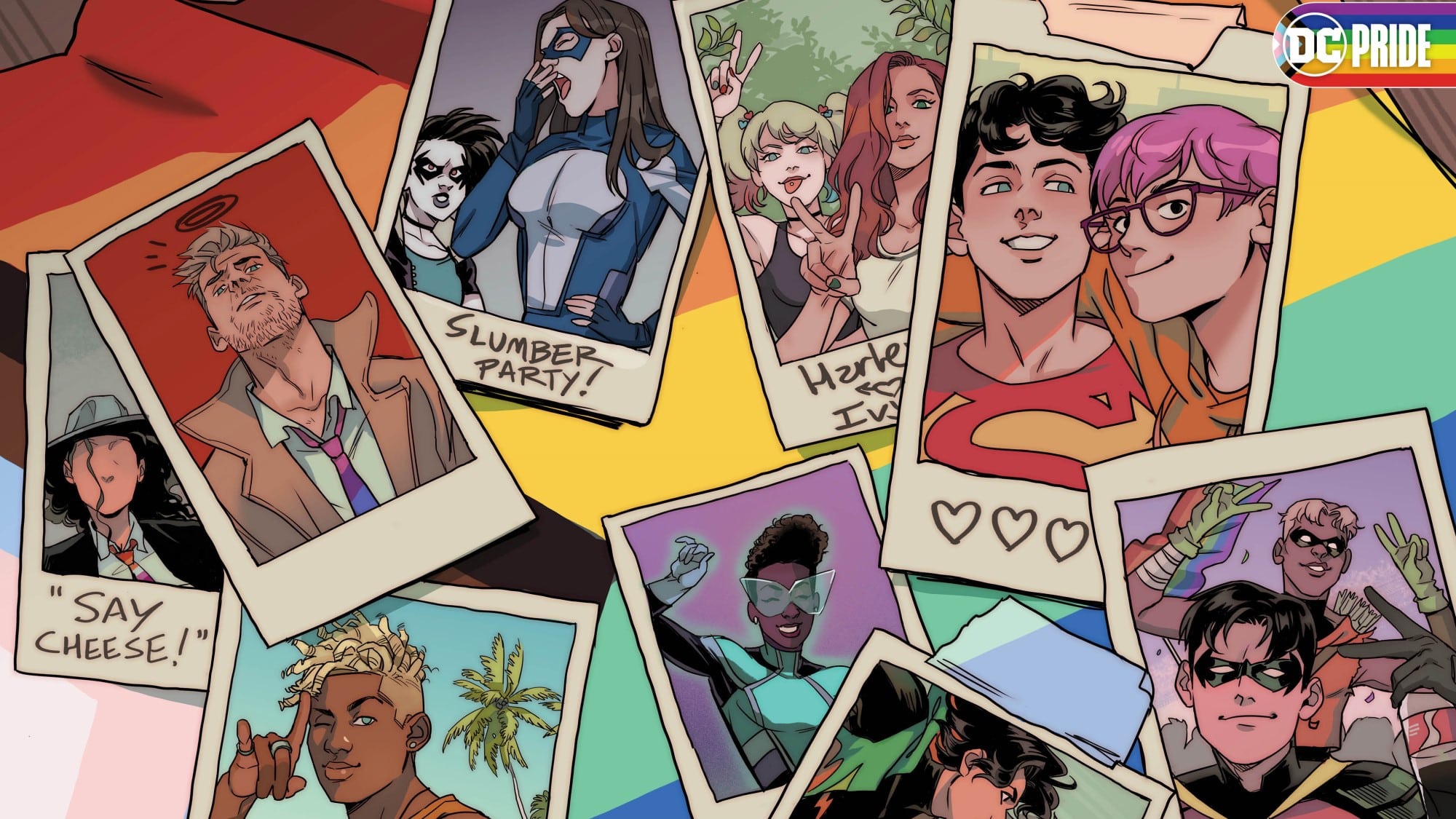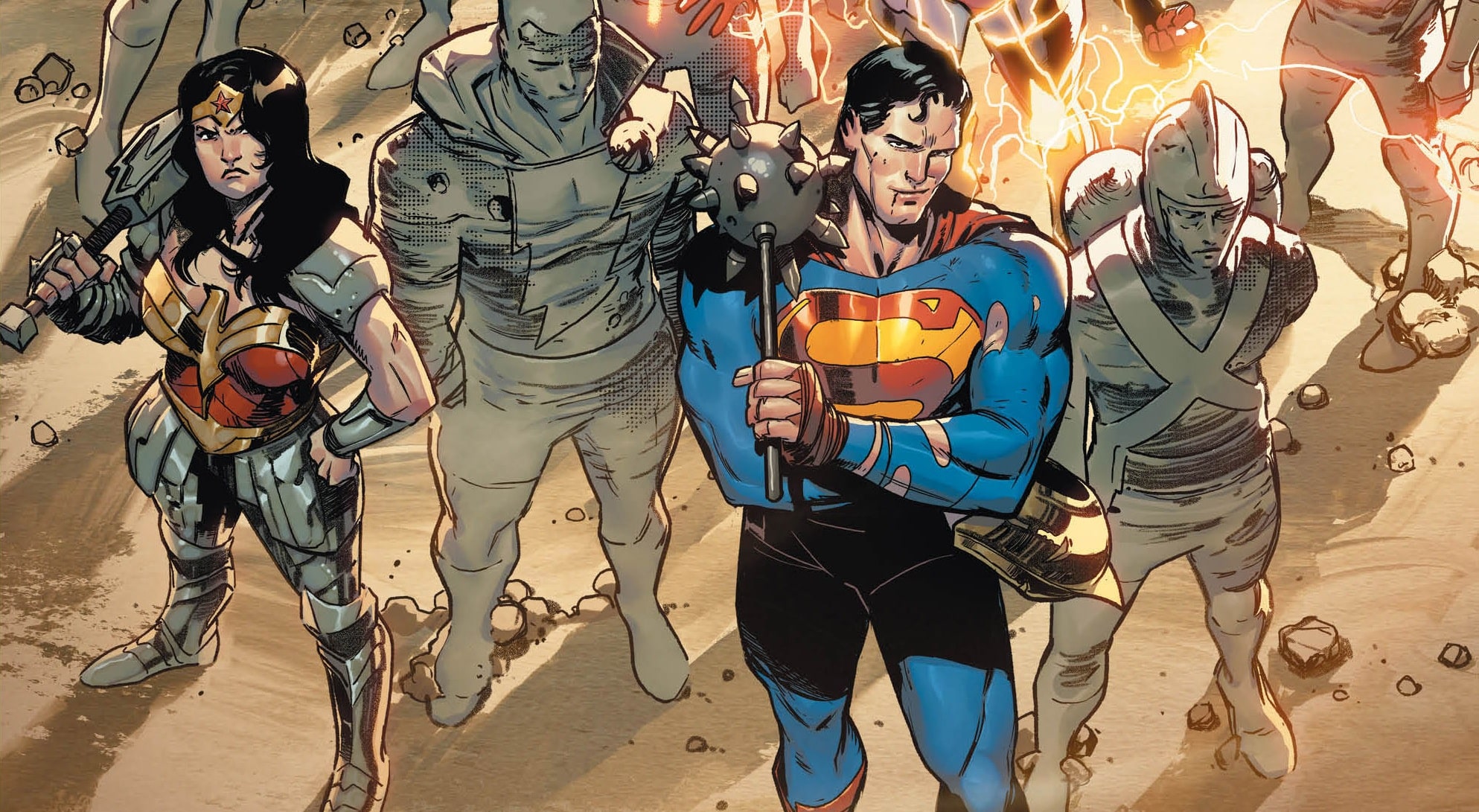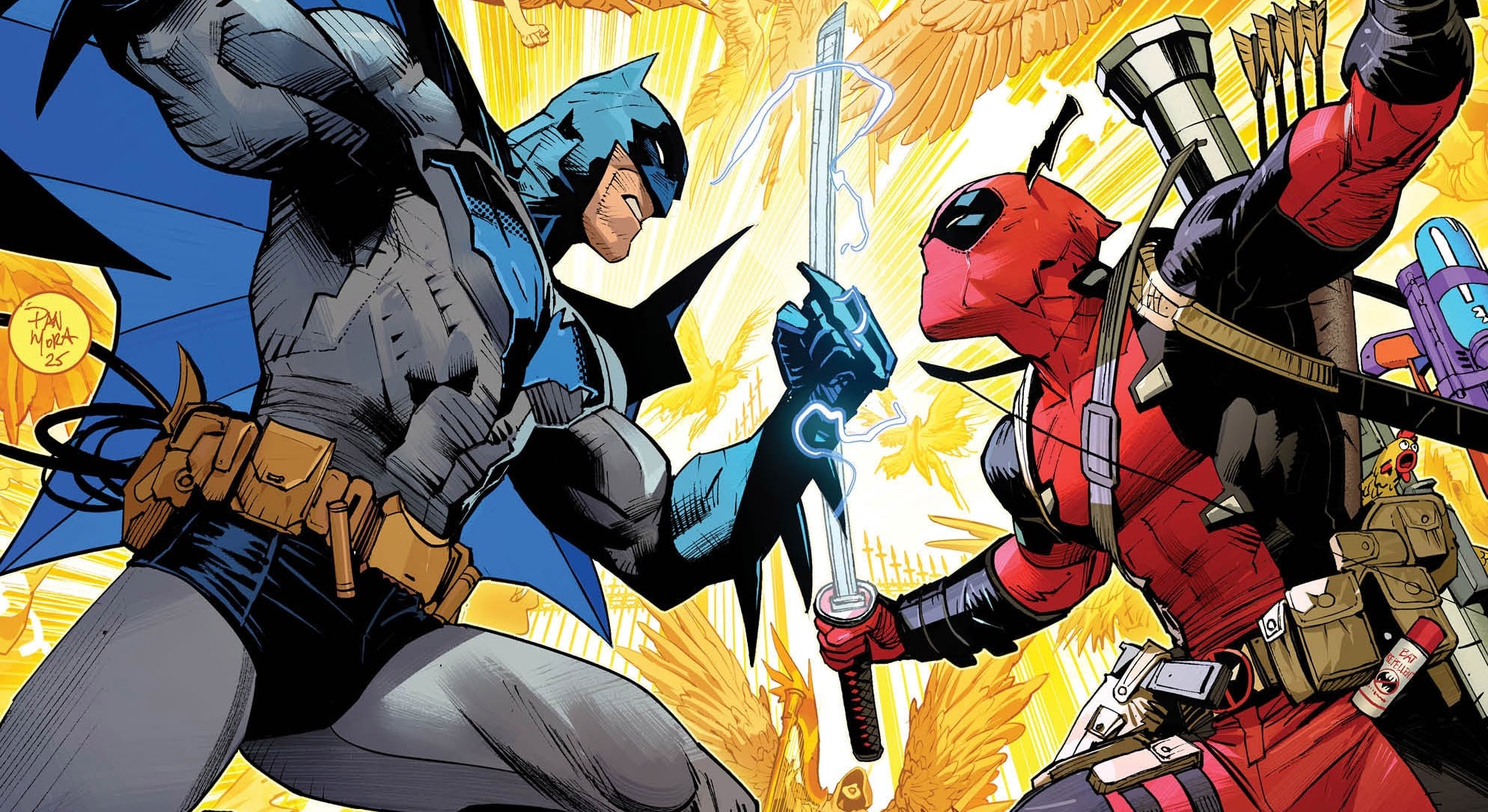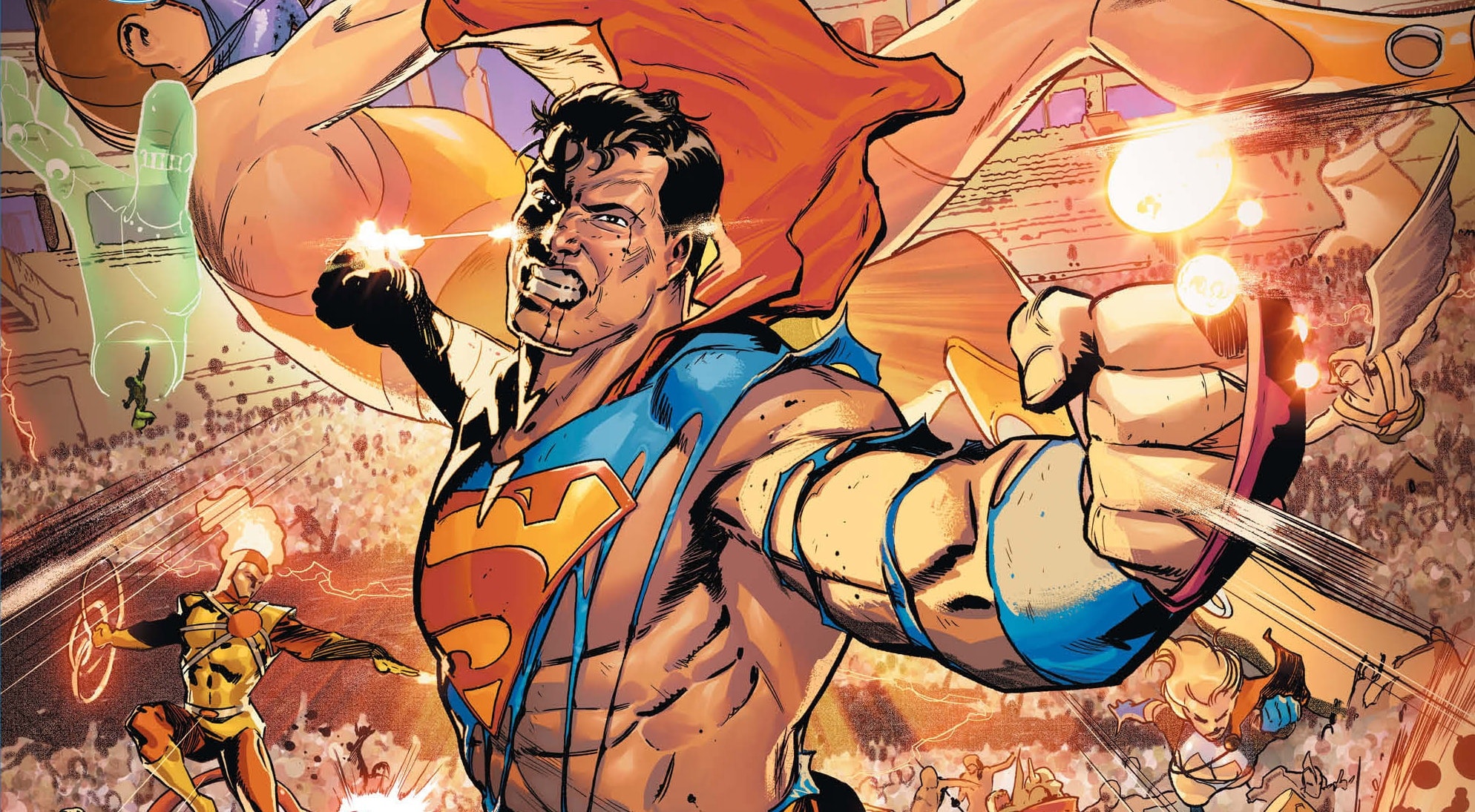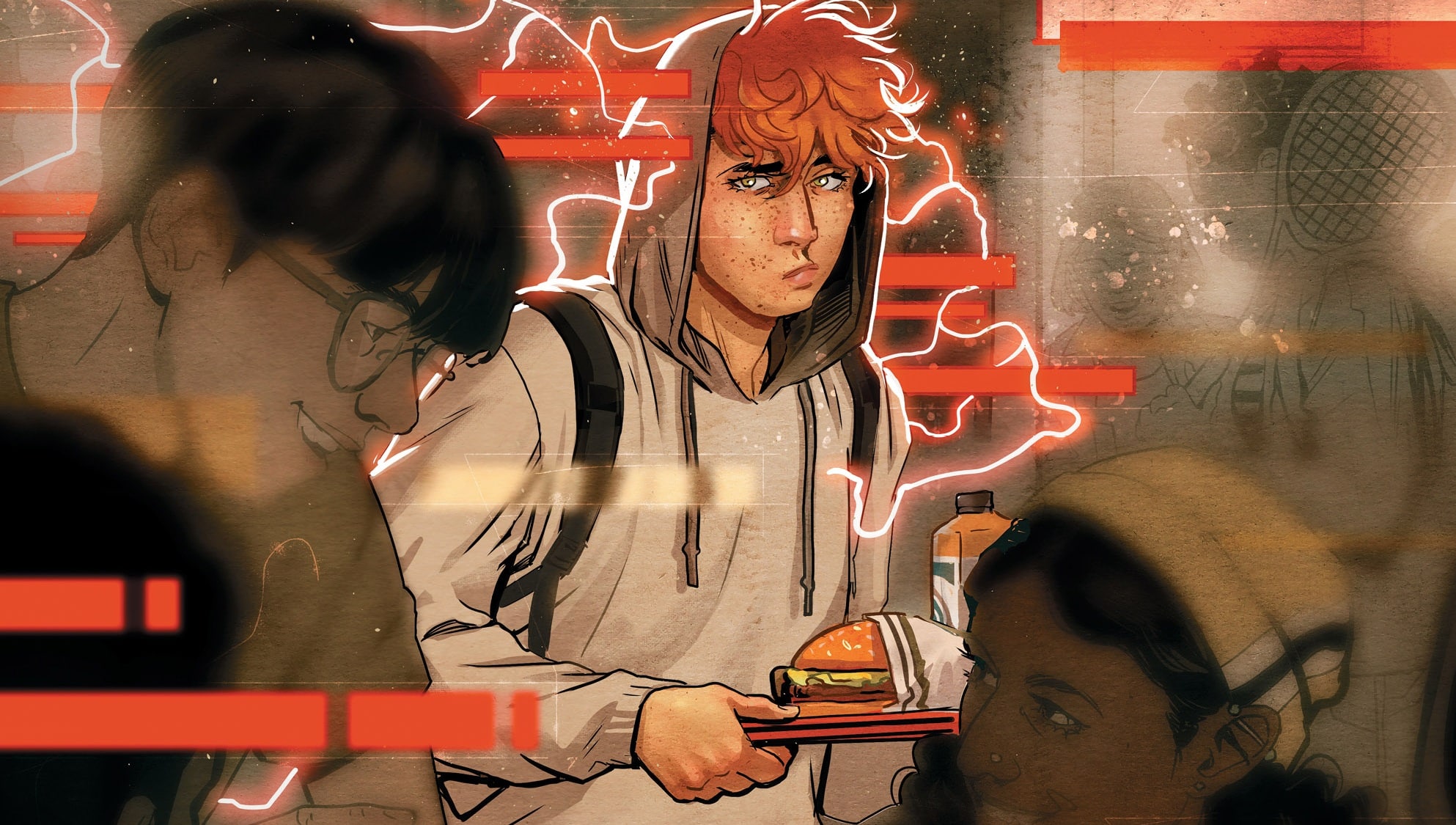Three pride specials from both of the Big Two companies, two CXF regulars with a lot to say about them. Welcome to Part 2 of our Pride issue coverage. This time we’re focusing on DC Pride 2023. Check out Part 1 here.
Sean: So DC’s Pride special was the obvious winner of Pride 2023, if for no other reason than it had a Grant Morrison comic about love finding a way to defeat bad writing and cosmic cruelty. There are many obvious things to say about “Love’s Lightning Heart” on the Morrison side, but I’d like to highlight Hayden Sherman’s contributions. There’s a subtlety to the way they draw our heroic Flashlight’s quest against death itself. This might come as a surprise considering the vast cosmos and colors on display, but it’s never presented as the most bombastic thing in the world. Rather, the camp on display is more akin to the work of Wes Anderson or John Waters where it feels completely natural. And it’s extremely amazing, to top it all off.
Stephanie: Agreed. And and and — as someone with mixed feelings about the Grant Morrison Multiversity, I like that this story makes sense both as a contribution to their Multiversity of meta-superhero comics, and as a de facto stand-alone story set in a universe where a Green Lantern from the Green Lantern Corps and a modern-day Flash, both dudes or at least male-presenting, just happen to be forever and ever in love. It looks great, too, and it looks, frankly, like a 1980s DC comic in the best possible way (George Perez, Keith Giffen). I wouldn’t compare it to Waters, though maybe Anderson. It’s sweet. And, also, this version of the Flash (named Red Racer, or Ray) collects old comics. Of course he does. Because he comes from (comic books’) past.
Sean: The rest of the collection, meanwhile, is a bit more … troubled. While the art on “And Baby Makes Three” by Paulina Ganucheau is quite charming, the story is a bit thin. There are points in here that feel quite a bit like something that would be charming as an out-of-context tumblr post, the sort of one-panel gag that site does wonders with. But as a narrative, it’s a bit thin, not using the eight pages it has to convey the narrative.
This is perhaps most evident in the scene where Ivy and Crush talk about their feelings. Instead of allowing the moment time to breathe over the course of a single page, we have this conversation crushed down into three panels over two pages. As such, Ganucheau isn’t able to convey the emotions these words imply, instead wasting time with cute “uwu” moments, including one where the characters literally write “uwu” in the beach instead of SOS. Literally, look at this panel:
We have an entire speech from Poison Ivy being delivered about the nature of her love with Harley Quinn. But it’s delivered entirely from behind her. Imagine if we saw Ivy’s face as she talks about her love of Harley. Imagine the poetic verse allowed if we were to split all these words out of the word salad Frank Cvetkovic is forced into here. In fact, I’ll demonstrate. Here’s how the original balloon reads out of context:
I’m in love with Harley for reasons I can’t even begin to enumerate but will spend a lifetime trying to anyway.
Now, with a few poetic devices, here’s how it could read:
I’m in love with Harley
For reasons I can’t even
Begin to enumerate
But will spend a lifetime trying to anyway.
See how each line emphasizes its own point to make up for the face that it’s an extremely run-on sentence. And that’s not even changing the punctuation or grammar to highlight the emotion of the moment, which would look like this:
I’m… in love with Harley
For reasons… I can’t even…
Begin to enumerate!
But I will spend a lifetime trying to anyway.
But because of the lack of economical storytelling here, we’re stuck with a poorly paced story of moments that will do well on tumblr and nowhere else.
Stephanie: Maybe I’m just way too much of a Leah Williams fangirl — belay that: I am absolutely too much of a Leah Williams fangirl — but I’ve got a different take: It’s a story designed to produce panels reused on tumblr, a story designed to go on longer than it needs to go on, so that all of us who have wondered what it would be like to get stuck on a desert island with Harley and Ivy get time to lose ourselves in it. The uwu is the whole point.
If you want a close-up of Harley and Ivy smooching, without any words that get in the way, you can get one. Before the sunset. After the pair of quotable wordless panels where Harley rides a dinosaur. And Ivy’s speech about how she and Harley complete each other has to be all in one panel, even if it requires the letterer to do his very best Orzechowski impression, because it’s designed to be quoted and sent by real-life lovers to real beloveds. If I want queer love poems with line breaks and no art, I can go elsewhere. To Cat Fitzpatrick, or Adrienne Rich. From Harley and Ivy and this frustrated, charming, bright blue queer teen, I want what we get.
Also, I love what Paulina Ganucheau does here. I just looked at some of her other DC work, and at her She-Ra, and these pages come even closer than those do to Saturday morning cartoon animation styles: flat colors, expressiveness above all, and yes, some uwu. It’s like Mike and Laura Allred got to revisit X-Statix except with queer warmth and sincerity rather than thick blankets of sarcasm. I could read a hundred pages of this sort of thing. YMMV.






Sean: In many regards, the failure of economical storytelling dampens the work of the usually pretty good Nadia Shammas in “Hey, Stranger.” Where the previous story focused on the uwu at the detriment of anything else, here the narrative is kinda weak in service of a page and a half dedicated to two characters monologuing at one another about their sexuality. Over the course of a single page.
Stephanie: Here you’re right. No one’s likely to put these panels up on tumblr, nor to incorporate them into a will-you-go-to-queer-prom-with-me card. I wonder if I’d feel differently if I were totally up on the Robins and their friends.
Sean: In some regards, there’s a sense that the focus should have been on the conversation itself (as an actual conversation instead of a pair of monologues) rather than spending three of the story’s six pages (the shortest in the entire one-shot) on faffing about with awkward silence. Yes, there is a degree of implication to the awkward silence, but the story doesn’t use it to a good enough extent that it justifies spending three pages on it before getting to the meat of the matter.
The obvious example is the three quarters of a page spread dedicated to the various points of Conner and Tim tying up the Scarecrow goons. While Bruka Jones draws the up-close moments with the awkward body language you’d expect of this moment, the distance required to use the De Luca effect makes this moment seem like the two are in sync with one another, as opposed to avoiding one another.
Stephanie: Six pages of conversation would give any Big Two artist working under Big Two constraints a hard row to hoe. Also, here’s the great Kelly Thompson — a writer, not an artist — explaining her fondness for the De Luca effect (you may have to scroll down a bit). We take our comics pleasures where we can find them.
Sean: “Subspace” is perhaps hurt in many ways by the ever vacuous void of Flash bullshit. Despite the brilliant art from AL Kaplan, I have absolutely no idea what is going on in this comic. What the fuck is the Still Force? Is anyone who is picking this book up without any idea what’s going on in Flash comics going to have any idea what the Still Force is?
Using the Morrison entry as contrast, we’re told immediately what the important things are regarding the continuity for the story: Our hero’s boyfriend is dead, and he wants to bring him back. Very straightforward to a reader who isn’t familiar with the events of Multiplicity. By contrast, Kaplan doesn’t even attempt to give an explanation to anything, despite being 10 pages long (second only to Morrison/Sherman’s 12 in terms of length). It assumes the reader is up to date on Flash comics, which is a pretty tall task considering most of them are absolute rubbish.
Stephanie: I haven’t read a single modern Flash comic because my friends say they’re absolute rubbish, and I agree that auteur (writer/artist) AL Kaplan is a worse comic book writer than Grant Morrison. Everyone’s a worse comic book writer than Grant Morrison, except for Vita Ayala, Chris Claremont, Louise Simonson and … I’ll stop now, but you get the point.
That said, I found this story a lot of fun, mostly because it looks beautiful. I assume the Still Force is the positron to the Speed Force’s electron, the yang to the Speed Force’s yin, the chocolate to the Speed Force’s peanut butter. There’s even a panel that tells us how to interpret it: “Everyone says the Still Force is the power towards ‘stasis and death.’ But death means change.” Basically a Tarot interpretation. Jules, or Julien, is a young queer hero just coming into their own and discovering new universes with new, speedy friends. I’ll take it!
Sean: And then there’s Josh Trujillo and Don Aguillo’s “Anniversary,” which is the one what everyone and their mother has been pissed off at. Let us put aside for a moment that Apollo and Midnighter’s whole deal is that they’re queer superheroes what are fine with smashing a bigot’s brains out. For that matter, let’s put aside that the genre of superhero fiction can be summed up as one with the base assumption that “might makes right.” Let us also put aside that there’s a cameo from the Stonewall Inn, an important landmark in queer history wherein queer people fought for their rights against bigots. (Remember kids, Pride started with a riot.)
Let us instead gander at the central question of the narrative (as light as it might be): What are the ethics of protesting? Is violence a useful tactic when dealing with the need to protest? Given the history of every single country, the answer is a universal “Yes, obviously.” Even putting aside that, one need only look at the recent decision on the part of corporations like Target or Bud Light to have buckled to the threats of fascists merely suggesting acting in violent ways.
Stephanie: Self-defense is always OK and sometimes required. Incremental reforms — and I would argue that we need incremental reforms! — usually require the people in power to get frightened of radical change, and sometimes even frightened of violence, first. Pride was a riot. And this is a bad, and badly paced, story. Denny O’Neill writing Green Lantern/Green Arrow 50 years ago did it better. And those comics haven’t necessarily aged well.
Sean: And what’s worse is the presence of Alan Scott Green Lantern here lecturing these new whippersnappers about the necessity of nonviolent protest. In the context of the story, he just comes completely out of nowhere to explain why acting in violence is bad and that we should have hope that our “non-violent” actions will have an impact. We are running late with these pieces, but it’s kind of rich seeing this when a recent protest of predominantly trans people involved the police watching as literal, actual Nazis beat them bloody.
Even then, the ultimate act of protest provided is representation. Which is absolutely great. But it’s not enough. The act of useful protest is an inherently violent one because it acts to disrupt the way things are. They deny that things are OK, refuse to allow things to remain as they are. It’s not simply the victory of being seen. We were seen in the ’90s and the ’80s and the ’70s, but that didn’t stop us from dying as people changed the channel to something else.
Stephanie: I wouldn’t use the word “violent” in the same way that you just used it, but otherwise, yep. If Alan Scott wants to stop Midnighter and Apollo from beating a bigot bloody, there are arguments he could use that I’d believe, but they’re tactical arguments (“You’re using excessive force,” for example, or “This particular act will impede this particular other effort going on across town, and we need publicity for that”). “Violence never works” is a terrible argument.
Sean: Most offensively is the invocation of the AIDS protests. There was a plague that killed an entire generation of us. The government ignored us because it was God’s Will that the homosexual, the transexual, the queer, the deviant die to His plague. We screamed and hollered, but no one heard. We even made our own collection of queer comics about our need to survive the plague, and still no one listened. Our deaths were something they could ignore. It took people who weren’t us, who were “Normal” getting the plague for them to decide to do something about it.
Stephanie: That and blocking the Brooklyn Bridge. And meeting with Anthony Fauci, over and over. And die-ins! You know what would have made this story incrementally better? If Alan Scott, or someone, had named ACT-UP. A story written for teens and adults should do better. A story written for young teens and kids, to provide some clumsy education, should at least give them something to Google.
Sean: Yeah, there’s a lack of specificity to the argument that hurts the case against violent action. What were those “radical actions of HIV/AIDS protesters?” Does anyone know what the “Zap” protests in the ’70s were? It’s all vague and unclear what’s being talked about in such a way as to prevent any thought regarding the real history being engaged with.
In the context of the larger DC Universe, this is worse. Alan Scott is the respectable member of the JSA, an organization who quit being superheroes because it got too hard for them after McCarthyism and did nothing for over 80 years. (That’s as much as eight tens. And that’s terrible.) The JSA, nowadays, are used by writers to represent the previous generation who knows better than these new whippersnappers. Who need to listen to their elders who quit about how they should act. Disobeying them will lead to failure and/or death. Because god forbid the angry young people have their own ideas about saving the world.
Also, the characters introduced for one-page gags to fight Nazis feel like they came out of that gag from Nextwave about queer superheroes whose whole character is that they’re queer.
Jumping into something more positive, Christopher Cantwell and Skylar Patridge’s “My Best Bet” was extremely charming. What it lacks in the direct engagement of the queerness of its two leads (Superman and John Constantine), it makes up for by being a dynamic story of Superman fighting a giant monster. Patridge’s design of the monster is extremely compelling as a creature of horror, and Cantwell’s writing of Jon Kent as headstrong, but in a different way than his old man, works wonders. One hopes he’ll get a turn at the guy proper once Taylor’s run is done.
But perhaps the most important piece here is the closing section of words about Rachel Pollack. For decades, her work at DC has been criminally marginalized, with her Doom Patrol run being pushed back and back from being collected in trade for close to a decade. To see this tribute to her here is heartwarming.
Stephanie: Agreed. In related news, the Rachel Pollack Doom Patrol collection is out! It’s $100 in hardback: if you can’t afford it, please consider asking your local (or university) library to purchase it. Patron requests can work! We don’t get a whole Rachel Pollack story reprinted, but we do get panels here and there by Pollack and artist Linda Medley, so you can see the kind of thing you’ve signed up for should you make the right choice and head for those stories (also available on DC’s infinite internet). Apart from and after her comics work, Pollack had a reputation as a world-class interpreter of Tarot, and a third reputation as a science fiction and fantasy novelist. She will be missed in many quarters.
Sean: As with any collection, there are some highs and some lows. The highs were pretty good, while the lows were some real stinkers.
Stephanie: I’d say one stinker and several highs, but OK! And before we say our queer goodbyes, I’d like to point at one more high, since comics are a visual medium. I have nothing special to say about the Batwoman/Xanthe story — it’s fine, Bat-people should read it, I’m not drawn to Xanthe, but you might be — but we should mention the one-page, one-panel, wordless, queer and trans splashiness that DC commissioned from some top queer and trans artists, starting with the transcendent Sophie Campbell!
And, also, right at the end we get the first few pages from the forthcoming DC YA graphic novel about Dreamer, the precognitive trans teen played on Supergirl, and now scripted in comics, by the admirable Nicole Maines, who was a teen trans activist years before she broke through on TV. There’s not enough here to say much about the plot, but the pages, by Rye Hickman and Bex Glendining, look psychedelically beautiful, like something out of Pollack and Medley’s Doom Patrol, with a soupcon of Sandman. I would recommend this annual to anyone, and that’s not something I’d say about the books we covered in part one.
Sean: I will say I am liking the art style of that GN.
Stephanie: See you next time in some fairy universe?
Stephanie Burt is Professor of English at Harvard. Her podcast about superhero role playing games is Team-Up Moves, with Fiona Hopkins; her latest book of poems is We Are Mermaids. Her nose still hurts from that thing with the gate.

